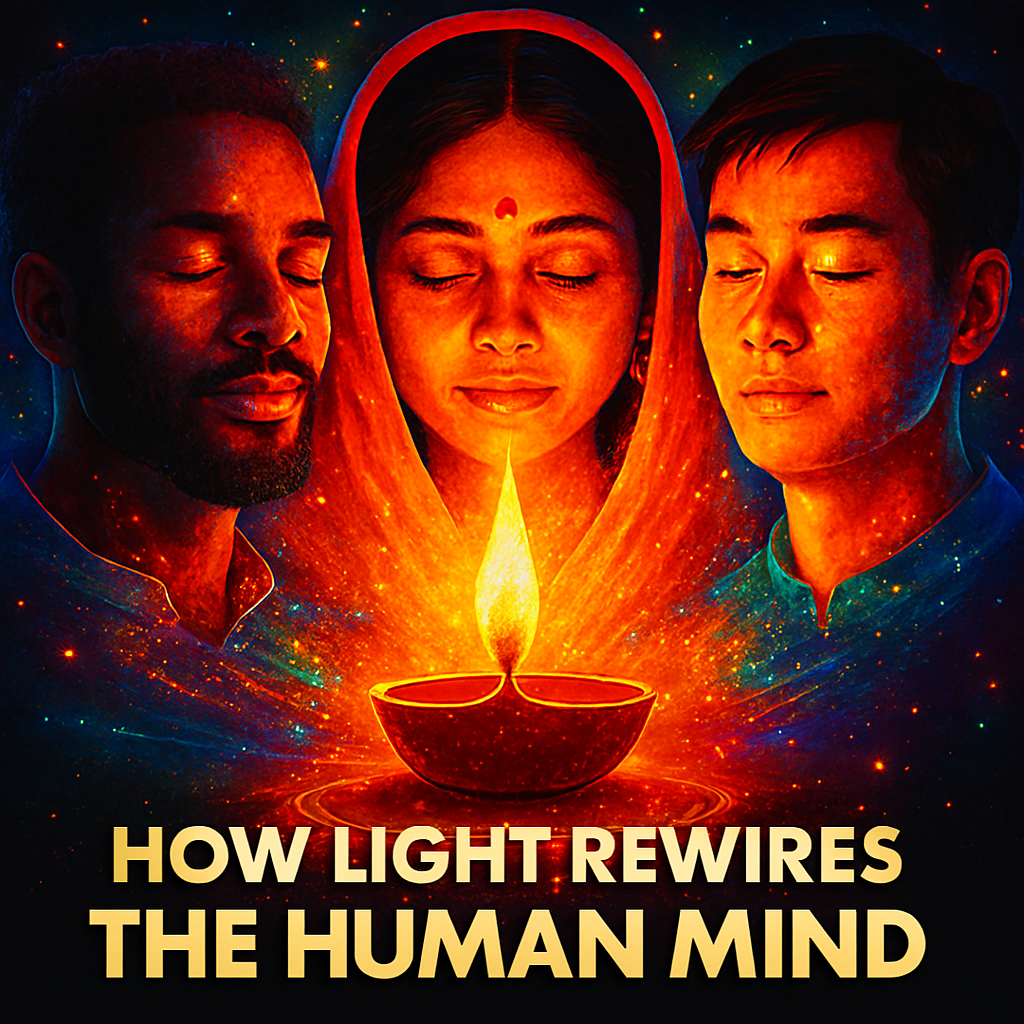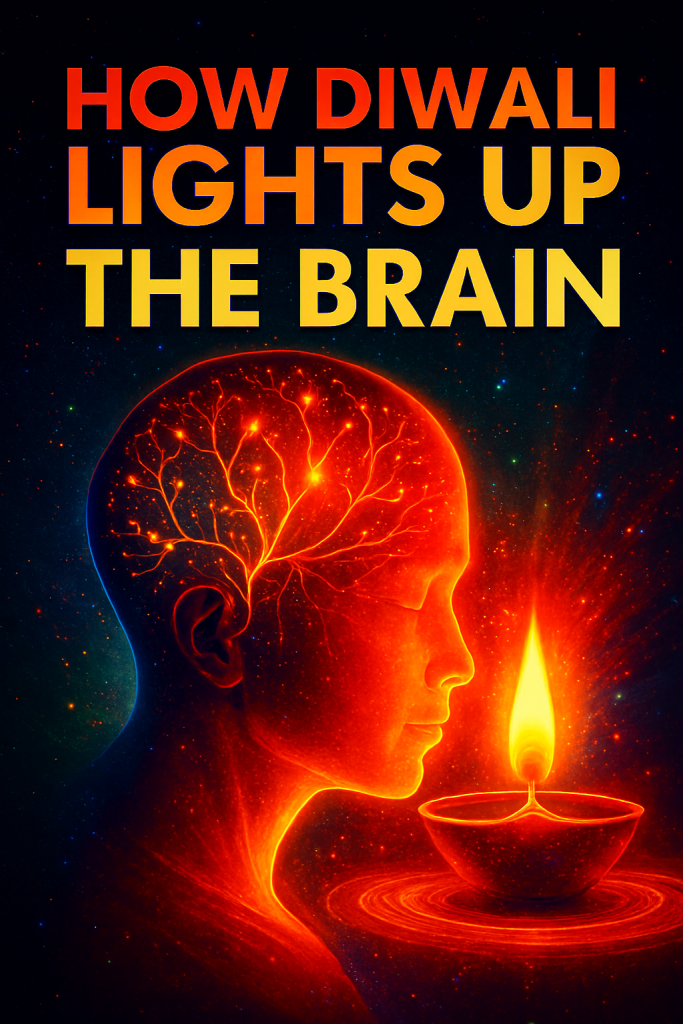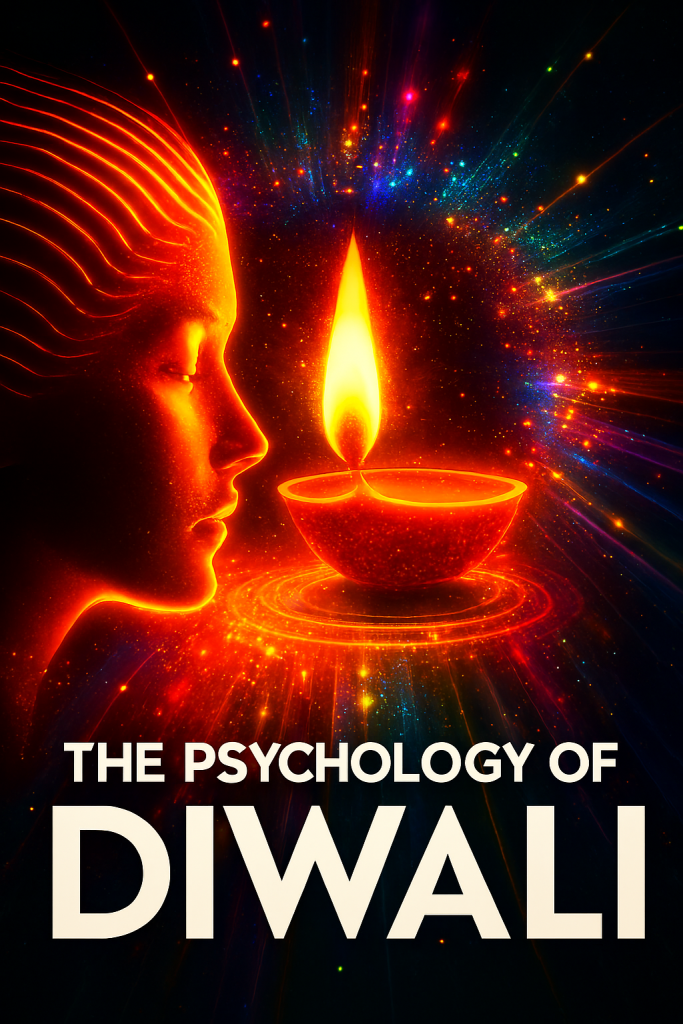
Diwali Beyond The Light
Psychology of Diwali
Diwali as a Psychological Reset – How Light and Ritual Reshape Human Behavior
Diwali functions as a structured emotional reset across five days of symbolic rituals. Each day introduces a distinct behavioral pattern that aligns with cognitive therapy principles. Cleaning the home activates the brain’s reward system through visible progress and environmental control. Lighting lamps stimulates the visual cortex and enhances mood via photic stimulation. Gifting and sharing trigger oxytocin release, reinforcing trust and social bonding. Fireworks provide sensory novelty that disrupts routine neural patterns and heighten arousal. Anticipation of the festival builds dopamine-driven motivation and goal orientation. Rituals like Lakshmi Puja create a sense of agency in uncertain environments.
Repetition of chants and prayers induces meditative brainwave states and emotional regulation. Traditional sweets elevate serotonin levels through carbohydrate intake and sensory pleasure. Wearing new clothes and decorating homes enhances self-image and environmental mastery. Collective participation in rituals strengthens group identity and emotional synchrony. Diwali’s structure mirrors therapeutic models of exposure, reward, and reflection. The festival’s rhythm supports emotional recalibration and behavioral reinforcement. Each symbolic act contributes to a layered psychological transformation.
| Ritual Element | Psychological Function | Neurochemical Impact |
|---|---|---|
| Cleaning | Cognitive clarity and agency | Dopamine |
| Lighting diyas | Visual stimulation and hope | Serotonin |
| Gifting | Social bonding and reciprocity | Oxytocin |
| Fireworks | Sensory novelty and arousal | Adrenaline, dopamine |
| Prayer | Mindfulness and control | Alpha brainwaves |

Symbolism of Light – Cognitive Effects of Illumination
Light in Diwali serves as both a literal and metaphorical agent of psychological transformation. Exposure to light reduces symptoms of seasonal affective disorder and enhances mood stability. The act of lighting diyas mimics exposure therapy for fear and uncertainty. In Hindu psychology, light represents the Atman, or inner self, reinforcing introspection. The flickering flame of a diya induces a trance-like state that aids meditation.
Light rituals are often performed at twilight, a liminal time that enhances suggestibility. Communal lighting of lamps fosters synchrony and shared emotional states. Light exposure regulates circadian rhythms and improves sleep quality. The golden hue of diyas aligns with color psychology’s association of yellow with optimism. Firelight triggers primal feelings of safety and community. Lighting lamps for others reinforces altruism and prosocial behavior. Repetition of this act strengthens neural pathways of gratitude and empathy. Light becomes a symbol of clarity, renewal, and emotional warmth. The visual dominance of light during Diwali reshapes cognitive associations with safety and joy. Diwali’s emphasis on illumination reflects deep psychological needs for visibility and connection.
| Light Symbol | Psychological Effect | Cultural Function |
|---|---|---|
| Diya | Focus and mindfulness | Inner clarity |
| Fireworks | Awe and sensory reset | Celebration |
| Lanterns | Hope and aspiration | Guidance |
| Torans | Threshold rituals | Transition |
| Rangoli candles | Creative expression | Joyful welcome |
Community Bonding – Social Neuroscience of Collective Celebration
Diwali activates the brain’s social cognition networks through collective rituals. Gathering with family and neighbors enhances feelings of belonging and emotional safety. Shared meals stimulate mirror neurons, increasing empathy and emotional resonance. Group rituals like pujas synchronize heart rates and breathing patterns. This physiological synchrony fosters emotional cohesion and group identity. Social laughter during Diwali gatherings releases endorphins and reduces stress. Giving and receiving gifts reinforces reciprocal altruism and trust.
Visiting relatives and friends strengthens intergenerational bonds and cultural continuity. Community events like melas create shared cultural memory and emotional imprinting. Collective anticipation builds communal dopamine cycles and shared excitement. Social identity theory explains how festivals reinforce in-group cohesion and pride. Participating in rituals reduces feelings of isolation and social anxiety. Presence of elders during rituals reinforces cultural transmission and respect. Children learn social norms through observation and mimicry during Diwali. The festival becomes a neuro-social training ground for empathy, cooperation, and joy.
| Social Activity | Psychological Outcome | Neurochemical Response |
|---|---|---|
| Family meals | Empathy and bonding | Oxytocin |
| Group pujas | Synchrony and cohesion | Endorphins |
| Gift exchange | Reciprocity and trust | Dopamine |
| Visiting elders | Continuity and respect | Serotonin |
| Community fairs | Shared memory | Emotional imprinting |
Ritual and Memory – Encoding Cultural Identity Through Repetition
Diwali rituals serve as mnemonic devices that encode cultural identity. Repetition of chants, gestures, and symbols strengthens memory consolidation. The hippocampus is activated during ritual participation, enhancing long-term recall. Rituals provide temporal anchors that organize autobiographical memory. Children exposed to Diwali rituals develop stronger cultural schemas. Sensory elements like scent, sound, and color enhance memory encoding. Ritual repetition creates emotional salience, increasing retention. Diwali’s annual rhythm reinforces intergenerational transmission of values. Memory is shaped by emotional intensity, which Diwali amplifies through multisensory engagement.
Rituals act as narrative structures that organize personal and collective identity. The symbolic layering of Diwali rituals supports semantic memory development. Cultural memory is reinforced through shared storytelling and mythological references. Ritual participation increases familiarity and reduces cognitive load. Diwali becomes a scaffold for encoding moral and social norms. Memory consolidation during Diwali supports identity formation and cultural resilience. The festival’s structure mirrors pedagogical models of experiential learning.
| Ritual Component | Memory Function | Cognitive Impact |
|---|---|---|
| Chants | Auditory encoding | Long-term retention |
| Scented oils | Olfactory memory | Emotional salience |
| Rangoli patterns | Visual memory | Schema reinforcement |
| Myth retelling | Narrative memory | Identity formation |
| Repetition | Procedural memory | Familiarity and fluency |
Emotional Regulation Through Ritual – Diwali’s Impact on Mood and Stress
Diwali rituals serve as structured emotional regulators across diverse age groups. The predictability of the festival reduces anxiety by providing temporal anchors. Rituals like lighting diyas and performing pujas offer a sense of control in chaotic environments. Sensory elements such as color, sound, and scent stimulate emotional processing centers. Fireworks, while controversial, provide cathartic release through auditory stimulation. The act of decorating spaces enhances environmental mastery and self-efficacy. Traditional music and chants activate the parasympathetic nervous system. Sweets and festive foods elevate mood through sensory pleasure and social sharing.
Wearing new clothes boosts self-esteem and body image. Social gatherings reduce loneliness and increase oxytocin levels. The repetition of rituals reinforces emotional stability. Diwali’s structure mirrors therapeutic models of exposure, reward, and reflection. Emotional intensity during the festival enhances memory consolidation. Ritual participation increases emotional literacy and self-awareness. The festival becomes a scaffold for emotional recalibration and resilience.
| Ritual Element | Emotional Function | Psychological Outcome |
|---|---|---|
| Lighting diyas | Control and focus | Reduced anxiety |
| Fireworks | Catharsis | Emotional release |
| Decorating | Environmental mastery | Self-efficacy |
| Music and chants | Parasympathetic activation | Calm and regulation |
| Social meals | Belonging | Mood elevation |
Cognitive Flexibility and Symbolic Reframing – Diwali as a Mental Pivot
Diwali encourages symbolic reframing of adversity through mythological narratives. Stories of Rama’s return and Krishna’s triumph offer cognitive models of resilience. These narratives activate the brain’s default mode network, enhancing imagination and meaning-making. Symbolic acts like lighting lamps represent triumph over darkness and ignorance. Rituals provide metaphors for personal transformation and renewal. The festival encourages cognitive flexibility by juxtaposing tradition with novelty. Rangoli designs stimulate creative thinking and spatial reasoning. The multiplicity of rituals allows for diverse interpretations and emotional engagement. Diwali’s layered symbolism supports abstract reasoning and moral reflection. The festival’s emphasis on light and renewal fosters optimism and future orientation.
Symbolic reframing reduces rumination and enhances psychological adaptability. Diwali rituals mirror therapeutic techniques like narrative therapy and cognitive restructuring. The festival becomes a platform for emotional storytelling and symbolic healing. Participation in symbolic acts strengthens neural pathways for resilience. Diwali’s cognitive architecture supports mental agility and emotional depth.
| Symbolic Element | Cognitive Function | Therapeutic Parallel |
|---|---|---|
| Rama’s return | Resilience model | Narrative therapy |
| Lighting lamps | Reframing adversity | Exposure therapy |
| Rangoli | Creative cognition | Art therapy |
| Myth retelling | Meaning-making | Cognitive restructuring |
| Gift exchange | Reciprocity | Behavioral activation |
Intergenerational Transmission – Diwali as a Cultural Learning System
Diwali facilitates intergenerational transmission of values and practices. Elders play a central role in guiding rituals and storytelling. Children learn through observation, imitation, and participation. Rituals serve as pedagogical tools for moral and social education. The festival reinforces respect, generosity, and community responsibility. Shared activities like cooking and decorating foster collaborative learning. Mythological stories provide ethical frameworks and behavioral models. Diwali’s repetition across years strengthens cultural continuity.
Sensory engagement enhances learning and memory retention. The presence of elders during rituals reinforces authority and tradition. Children internalize cultural norms through embodied participation. Diwali becomes a living curriculum of values and identity. The festival supports experiential learning and emotional development. Intergenerational bonding during Diwali enhances family cohesion. Cultural transmission during Diwali strengthens identity and resilience.
| Learning Mode | Age Group | Psychological Benefit |
|---|---|---|
| Observation | Children | Norm acquisition |
| Storytelling | All ages | Ethical modeling |
| Ritual participation | Adolescents | Identity formation |
| Sensory engagement | Young children | Memory encoding |
| Collaborative tasks | Families | Bonding and cohesion |
Global Adaptation – Diwali’s Psychological Influence Beyond India
Diwali’s psychological impact extends beyond its cultural origins. In diaspora communities, the festival reinforces identity and belonging. Celebrating Diwali abroad provides emotional continuity and cultural anchoring. Rituals adapt to local contexts while preserving symbolic integrity. Diwali fosters multicultural dialogue and inclusion. Non-Hindu participants engage with the festival through shared values of light and renewal. Schools and workplaces incorporate Diwali into diversity programming.
The festival’s emphasis on gratitude and generosity resonates across cultures. Diwali’s visual and sensory appeal enhances cross-cultural engagement. Global celebrations mirror psychological functions of bonding and renewal. Diwali becomes a tool for emotional integration in multicultural societies. The festival supports acculturation and emotional resilience among immigrants. Diwali’s adaptability reflects its psychological universality. Rituals retain their emotional potency across geographic boundaries. Global Diwali celebrations reinforce shared human values and emotional needs.
| Region | Adaptation Mode | Psychological Outcome |
|---|---|---|
| North America | School events | Inclusion and identity |
| UK | Community fairs | Belonging and cohesion |
| Australia | Workplace celebrations | Cultural literacy |
| Singapore | Public lighting | Shared values |
| UAE | Family rituals | Continuity and bonding |
Sensory Immersion and Neuroaesthetics – Diwali’s Impact on Perception and Emotion
Diwali engages all five senses in a coordinated ritual experience. Visual stimuli include vibrant colors, intricate rangoli designs, and flickering lamps. Auditory elements range from devotional music to the explosive sounds of fireworks. Olfactory cues include incense, marigold garlands, and festive cooking aromas. Tactile experiences involve new fabrics, handcrafted decorations, and physical rituals. Gustatory pleasure is delivered through traditional sweets and savory dishes. This multisensory immersion activates the brain’s limbic system, enhancing emotional intensity. Neuroaesthetics explains how beauty and symmetry in rituals influence mood and cognition.
Rangoli patterns stimulate the visual cortex and promote spatial reasoning. Incense and floral scents trigger olfactory memory and emotional recall. Music and chants regulate heart rate and induce relaxation. Fireworks create a temporary sensory overload that resets attention. The layering of sensory inputs enhances ritual salience and emotional imprinting. Diwali’s sensory architecture supports neuroplasticity and emotional learning. Rituals become emotionally charged experiences that shape perception and memory. The festival’s aesthetic richness deepens psychological engagement and cultural resonance.
| Sensory Modality | Ritual Element | Psychological Effect |
|---|---|---|
| Visual | Rangoli, lamps | Focus and joy |
| Auditory | Music, fireworks | Arousal and relaxation |
| Olfactory | Incense, flowers | Memory and mood |
| Tactile | Fabrics, decorations | Embodiment and presence |
| Gustatory | Sweets, meals | Pleasure and bonding |

Temporal Psychology – Diwali’s Role in Annual Emotional Cycles
Diwali marks a psychological pivot in the annual emotional calendar. The festival occurs during autumn, a season associated with reflection and transition. Its timing aligns with agricultural cycles and fiscal resets in many regions. Diwali provides a temporal anchor for emotional recalibration. The anticipation of the festival builds motivational momentum. Rituals offer closure for past events and renewal for future goals. Diwali’s annual rhythm supports emotional continuity and resilience. The festival’s timing enhances its symbolic power as a threshold event.
Temporal psychology explains how recurring events shape emotional expectations. Diwali rituals create emotional punctuation in the year’s narrative arc. The festival’s structure mirrors seasonal affective regulation strategies. Annual repetition strengthens emotional memory and cultural identity. Diwali becomes a psychological landmark for reflection and aspiration. The festival’s timing supports goal setting and behavioral renewal. Temporal rituals during Diwali reinforce emotional stability and future orientation.
| Temporal Element | Psychological Function | Seasonal Impact |
|---|---|---|
| Autumn timing | Reflection and transition | Emotional recalibration |
| Annual rhythm | Continuity and resilience | Memory consolidation |
| Fiscal alignment | Renewal and planning | Motivation boost |
| Ritual closure | Emotional punctuation | Stress reduction |
| Anticipation | Dopamine activation | Future orientation |
Moral Psychology and Ethical Framing – Diwali’s Influence on Values
Diwali reinforces moral values through symbolic and narrative structures. Mythological stories emphasize justice, courage, and compassion. Rituals promote generosity, gratitude, and humility. Ethical behavior is modeled through gift-giving and community service. Diwali’s emphasis on light symbolizes moral clarity and truth. The festival encourages reflection on personal and collective ethics. Rituals like Lakshmi Puja reinforce values of prosperity and responsibility. Diwali becomes a platform for moral storytelling and ethical learning. Children internalize values through embodied participation and observation. Moral psychology explains how rituals shape ethical reasoning and behavior.
Diwali’s narratives activate moral emotions like empathy and fairness. Rituals provide opportunities for ethical decision-making and reflection. The festival supports development of prosocial behavior and civic responsibility. Diwali’s moral architecture strengthens cultural norms and ethical resilience. Ritual participation enhances moral identity and emotional intelligence. The festival becomes a living curriculum of ethical values and social cohesion.
| Moral Theme | Ritual Expression | Psychological Outcome |
|---|---|---|
| Justice | Rama’s return | Ethical modeling |
| Generosity | Gift exchange | Prosocial behavior |
| Gratitude | Lakshmi Puja | Emotional intelligence |
| Humility | Community service | Moral identity |
| Truth | Lighting lamps | Value reinforcement |
Diwali as a Psychological Ecosystem – Integrating Ritual, Emotion, and Identity
Diwali functions as a holistic psychological ecosystem. The festival integrates ritual, emotion, memory, and social bonding. Each element contributes to a layered experience of identity and renewal. Rituals provide structure and symbolic meaning. Emotional intensity enhances memory and engagement. Social participation reinforces belonging and cultural continuity. Sensory immersion deepens psychological imprinting. Temporal rhythm supports emotional regulation and future planning. Symbolic reframing fosters resilience and cognitive flexibility.
Moral narratives shape ethical reasoning and behavior. Intergenerational transmission ensures cultural sustainability. Global adaptation reflects Diwali’s psychological universality. The festival becomes a scaffold for emotional literacy and identity formation. Diwali’s architecture mirrors therapeutic models of healing and growth. Ritual participation activates multiple neural pathways. The festival supports neuroplasticity and emotional recalibration. Diwali’s psychological ecosystem offers a blueprint for holistic well-being. Its layered structure transforms individual and collective consciousness.
| Psychological Domain | Diwali Function | Outcome |
|---|---|---|
| Emotion | Ritual intensity | Regulation and joy |
| Cognition | Symbolic reframing | Flexibility and meaning |
| Memory | Sensory layering | Retention and identity |
| Social | Group rituals | Belonging and cohesion |
| Ethics | Moral narratives | Values and resilience |
Conclusion – Diwali as a Blueprint for Psychological Renewal and Cultural Continuity
Diwali is far more than a seasonal celebration. It operates as a multi-layered psychological framework that integrates emotion, cognition, ritual, and identity. The festival’s structure mirrors therapeutic models of healing, resilience, and renewal. Rituals provide emotional punctuation and symbolic reframing. Sensory immersion deepens memory and emotional imprinting. Social participation reinforces belonging and intergenerational continuity. Diwali’s timing supports annual emotional cycles and future orientation. The festival’s moral narratives shape ethical reasoning and prosocial behavior. Global adaptation reflects Diwali’s psychological universality and cultural elasticity. Each ritual element contributes to a holistic ecosystem of well-being. Diwali becomes a living curriculum of values, identity, and emotional intelligence.
Its layered architecture supports neuroplasticity and cognitive flexibility. The festival’s aesthetic richness enhances psychological engagement and cultural resonance. Diwali offers a blueprint for integrating tradition with emotional renewal. Its symbolic power lies in its ability to transform darkness into clarity. The psychology of Diwali reveals how ritual can reshape perception, behavior, and collective consciousness. In a fragmented world, Diwali’s structure offers a model for emotional coherence and cultural resilience.
| Psychological Dimension | Diwali Mechanism | Outcome |
|---|---|---|
| Emotion | Ritual intensity | Regulation and joy |
| Cognition | Symbolic reframing | Flexibility and meaning |
| Memory | Sensory layering | Retention and identity |
| Social | Group rituals | Belonging and cohesion |
| Ethics | Moral narratives | Values and resilience |
Join the Discussion – How Does Diwali Reshape Your Inner World?
We invite readers, educators, psychologists, and cultural practitioners to reflect on the psychological architecture of Diwali. How do its rituals influence your emotional cycles, social bonds, or ethical frameworks? What symbolic elements resonate most deeply with your personal or professional practice? Have you observed Diwali’s impact across different cultural or geographic contexts?
#PsychologyOfDiwali #RitualAndResilience #EmotionalArchitecture #SymbolicHealing #NeuroaestheticsInCulture #DiwaliAcrossBorders #CulturalContinuity #FestivalAsTherapy #SensoryRituals #EthicalCelebration #MindfulTradition #DiwaliEditorial #EmotionalLiteracy #CognitiveRenewal #InclusiveRitualDesign



1 thought on “The Magical Psychology Of Diwali Even Beyond 2025”